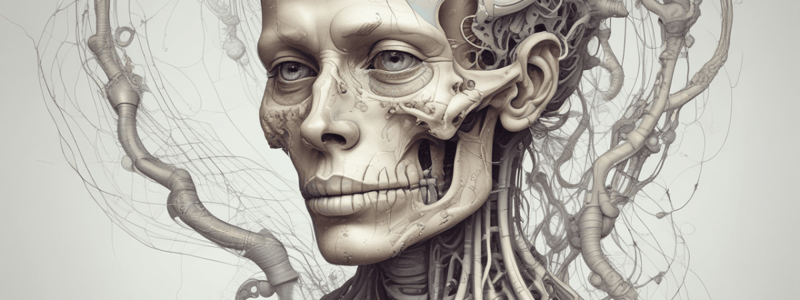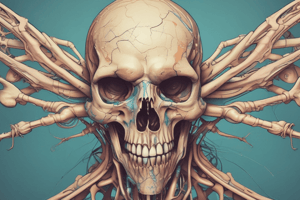Podcast
Questions and Answers
What is the name of the gene responsible for encoding a protein that plays a crucial role in bone growth and maintenance?
What is the name of the gene responsible for encoding a protein that plays a crucial role in bone growth and maintenance?
- FGFR3 (correct)
- FGFR2
- FGFR1
- FGFR4
What is the mode of inheritance of achondroplasia?
What is the mode of inheritance of achondroplasia?
- Mitochondrial
- Autosomal recessive
- Autosomal dominant (correct)
- X-linked
What is the effect of the mutation in the FGFR3 gene on chondrocytes?
What is the effect of the mutation in the FGFR3 gene on chondrocytes?
- It inhibits their proliferation and maturation (correct)
- It increases their apoptosis
- It stimulates their proliferation and maturation
- It has no effect on them
What is the percentage of cases where achondroplasia results from new (de novo) mutations?
What is the percentage of cases where achondroplasia results from new (de novo) mutations?
What happens if both parents have achondroplasia?
What happens if both parents have achondroplasia?
What is the role of the FGFR3 protein in the body?
What is the role of the FGFR3 protein in the body?
What is the chance of a child inheriting achondroplasia if one parent has the condition?
What is the chance of a child inheriting achondroplasia if one parent has the condition?
What is the fate of a child who inherits two copies of the mutated FGFR3 gene?
What is the fate of a child who inherits two copies of the mutated FGFR3 gene?
What is the effect of FGFR3 activation on chondrocytes in endochondral bone?
What is the effect of FGFR3 activation on chondrocytes in endochondral bone?
What is the characteristic feature of the forehead in individuals with achondroplasia?
What is the characteristic feature of the forehead in individuals with achondroplasia?
What is the result of inhibition of cartilage during early development?
What is the result of inhibition of cartilage during early development?
What is midface hypoplasia?
What is midface hypoplasia?
What is the purpose of monitoring growth patterns in individuals with achondroplasia?
What is the purpose of monitoring growth patterns in individuals with achondroplasia?
What is the characteristic feature of the nasal bone in individuals with achondroplasia?
What is the characteristic feature of the nasal bone in individuals with achondroplasia?
What is the role of FGFR3 in endochondral bone?
What is the role of FGFR3 in endochondral bone?
What is the characteristic feature of the hands and feet in individuals with achondroplasia?
What is the characteristic feature of the hands and feet in individuals with achondroplasia?
What is the main purpose of genetic testing for achondroplasia?
What is the main purpose of genetic testing for achondroplasia?
What is the result of midface hypoplasia in achondroplasia?
What is the result of midface hypoplasia in achondroplasia?
What is the implication of delayed dental development in achondroplasia?
What is the implication of delayed dental development in achondroplasia?
What is the primary cause of achondroplasia?
What is the primary cause of achondroplasia?
What is the purpose of monitoring height, weight, and head circumference in infancy?
What is the purpose of monitoring height, weight, and head circumference in infancy?
What is the result of dental crowding in achondroplasia?
What is the result of dental crowding in achondroplasia?
What is the purpose of Non-Invasive Prenatal Testing (NIPT)?
What is the purpose of Non-Invasive Prenatal Testing (NIPT)?
What is the type of malocclusion commonly associated with achondroplasia?
What is the type of malocclusion commonly associated with achondroplasia?
What is characterized by constricted upper and lower dental arches?
What is characterized by constricted upper and lower dental arches?
What can affect speech and feeding?
What can affect speech and feeding?
What is a problem with how the teeth come together?
What is a problem with how the teeth come together?
What is associated with dental crowding and malocclusion?
What is associated with dental crowding and malocclusion?
What is crucial for comprehensive care?
What is crucial for comprehensive care?
What may be necessary to correct jaw alignment in severe cases of malocclusion and maxillary hypoplasia?
What may be necessary to correct jaw alignment in severe cases of malocclusion and maxillary hypoplasia?
What is a management strategy to address the narrow maxilla and improve dental arch space?
What is a management strategy to address the narrow maxilla and improve dental arch space?
What is a frequent dental visit to monitor dental development, manage caries risk, and address any emerging issues promptly?
What is a frequent dental visit to monitor dental development, manage caries risk, and address any emerging issues promptly?
Flashcards are hidden until you start studying
Study Notes
What is Achondroplasia?
- A genetic disorder that affects the fibroblast growth factor receptor (FGFR3) protein, which regulates bone growth and maintenance.
- The most common type of short stature skeletal dysplasia or dwarfism.
Genetic Mutations
- Caused by specific pathogenic variants in FGFR3 on chromosome 4.
- An autosomal dominant disorder, where one copy of the mutated gene is sufficient to cause the disorder.
- 80% of cases result from new (de novo) mutations, which occur spontaneously in the sperm or egg of one of the parents or during early embryonic development.
Pathogenesis
- A specific mutation in the FGFR3 gene leads to an overactive receptor, inhibiting the proliferation and maturation of chondrocytes, which are responsible for cartilage formation.
- This results in shortened and improperly formed bones, particularly affecting the long bones in the arms and legs.
Signs and Symptoms
- Shortened bones (thigh, upper arm)
- Short hands and feet
- Large separation between third and fourth fingers
- Head is larger than normal
- Prominent forehead
- Midface hypoplasia
- Delayed development in infants (sitting, crawling, walking)
- Foramen magnum stenosis
Diagnosis
- Clinical Examination: Physical features such as large head size, prominent forehead, midface hypoplasia, short arms and legs, and short stature.
- Radiographic Examination: X-rays reveal characteristic skeletal abnormalities, such as shortening of the long bones, a narrowed foramen magnum, and a small vertebral canal.
- Genetic Testing: FGFR3 mutation testing can identify the mutations.
Treatment and Management
- No specific treatment for achondroplasia, but managing symptoms and monitoring height, weight, and head circumference during infancy.
- No cure for achondroplasia, but most people with the condition can live full and healthy lives.
Oral and Dental Manifestations
- Midface hypoplasia: underdevelopment of the midface, resulting in a concave facial profile and a prominent lower jaw.
- Dental crowding: reduced space in the upper jaw, leading to crowding of teeth.
- Delayed dental development: slower eruption of primary and permanent teeth.
- Malocclusion: misalignment of teeth, particularly Class III malocclusion (underbite).
- Narrow dental arches: constricted upper and lower dental arches.
- High-arched palate: elevated roof of the mouth, affecting speech and feeding.
- Bite issues: problems with how the teeth come together, affecting chewing and speech.
- Increased risk of dental caries and periodontal disease: higher risk of cavities and gum disease due to crowding and difficulty in maintaining oral hygiene.
- Jaw growth and function problems: abnormal jaw growth patterns, leading to chewing difficulties and temporomandibular joint (TMJ) disorders.
- Airway obstruction: narrowing of the airway due to facial structure anomalies, leading to obstructive sleep apnea.
Management Strategies
- Interdisciplinary approach: collaboration between pediatric dentists, orthodontists, maxillofacial surgeons, and other healthcare providers.
- Early orthodontic intervention: early assessment by an orthodontist to plan for space maintenance, expansion of dental arches, and correction of malocclusion.
- Maxillary expansion: rapid maxillary expansion may be indicated to address the narrow maxilla and improve dental arch space.
- Orthognathic surgery: in severe cases of malocclusion and maxillary hypoplasia, orthognathic surgery may be necessary to correct jaw alignment.
- Regular dental check-ups: frequent dental visits to monitor dental development, manage caries risk, and address any emerging issues promptly.
Studying That Suits You
Use AI to generate personalized quizzes and flashcards to suit your learning preferences.




